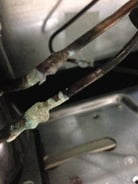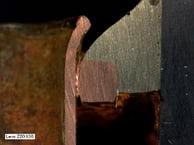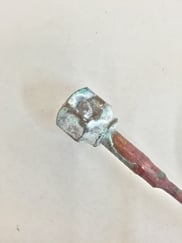Depending on your brazing process, you may need to perform post-braze joint cleaning to remove residual flux. This step can be crucial since most fluxes are corrosive. Post-braze cleaning is one of the Six Fundamentals of Brazing*.

Reasons to Remove Flux
Let's examine five reasons why post-braze flux removal is important:
1. You cannot inspect a joint that is covered with flux.
2. Flux can act as a bonding agent and may be holding the joint together, without successful brazing. This joint would fail during service.
3. In pressure service, flux may mask pinholes in a braze joint, even though it withstands a pressure test. The joint would leak soon after being placed into service.
(Above Picture: Refrigeration Line Corrosion)
4. Flux is hygroscopic, so residual flux attracts available water from the environment. This leads to corrosion.
5. Paint or other coatings do not stick to areas covered with residual flux.
Ways to Remove Flux
After brazing, flux forms a hard, glass-like surface and can be difficult to remove. What is the best cleaning method? You can remove excess flux by various means; the most cost-effective approaches involve water.
What is the best cleaning method? You can remove excess flux by various means; the most cost-effective approaches involve water.
Industry flux standards focus on water-based fluxes. AMS 3410 and AMS 3411 stipulate that all fluxes conforming to these specifications should be soluble in water at 175°F/79°C or less after brazing. Therefore, brazing fluxes are typically designed to dissolve in water.
(Above Picture: Flux-Masked Leak Path)
The most common methods for post-braze flux removal are:
- Soaking/wetting - Use hot water with agitation in a soak tank to remove excess flux immediately following the braze operation, and then dry the assembly. When soaking is not possible, use a wire brush along with a spray bottle or wet towel.
- Quenching - This process induces a thermal shock that cracks off residual flux. When quenching a brazed part in hot water, take care to avoid compromising the braze joint. Quench only after the braze filler metal has solidified to avoid cracks or rough braze joints. Note that quenching can affect base material mechanical properties. Do not quench materials with large differences in coefficients of thermal expansion to avoid cracks in the base materials and tears within the braze alloy.
Additional cleaning methods include:
- Steam lance cleaning - This process employs super-heated steam under pressure to dissolve and blast away flux residue.
- Chemical cleaning - You can use an acidic or basic solution, generally with short soak times to avoid deteriorating the base materials.
- Mechanical cleaning - Clean residue from brazed joints with a wire brush or by sandblasting. Be advised that soft metals-including aluminum-require extra care, as they are vulnerable to the embedding of particles.
When using a soak bath of any kind, change the solution periodically to avoid saturating the cleaning solution. For chemical soaks, monitor the pH level to determine when to change the solution.
Always ensure that your cleaning method is compatible with base metal properties. Some metal groups achieve a desired effect from a special treatment after cleaning. Stainless-steel aluminum parts, for example, may benefit from chemical immersion to improve surface corrosion resistance.
CONCLUSION:
Depending on your brazing process, you may need to perform post-braze joint cleaning to remove residual flux. This step is crucial for several reasons; including the corrosive nature of most fluxes and the possibility that excess flux could contribute to joint failure. The most common cleaning methods involve water-specifically soaking/wetting and quenching.
(Above PIcture: Brass-Copper Flux Corrosion)
* For more information on post-braze cleaning as part of the Six Fundamentals of Brazing, see Lucas-Milhaupt® postings: Fundamentals of Brazing Part I and Fundamentals of Brazing Part II. We are pleased to provide expert information for Global Brazing Solutions® through our blogs and instructional videos. Feel free to share this posting with associates, and save our blog site to your Favorites.
Questions about flux materials for your application? Contact us for further assistance. For detailed questions regarding specific applications, please call the Lucas-Milhaupt Technical Services Department at 800.558.3856.
Reference Source: AWS Brazing Handbook, Fifth Edition. American Welding Society, 2007.
Disclaimer: Lucas-Milhaupt, Inc. believes the information contained herein to be reliable. However, Lucas-Milhaupt gives the technical information without charge, and the user shall use such information at its own discretion and risk. Results are calculated based on nominal values, and actual weights and dimensions may vary due to dimensional and chemical tolerance variation.

